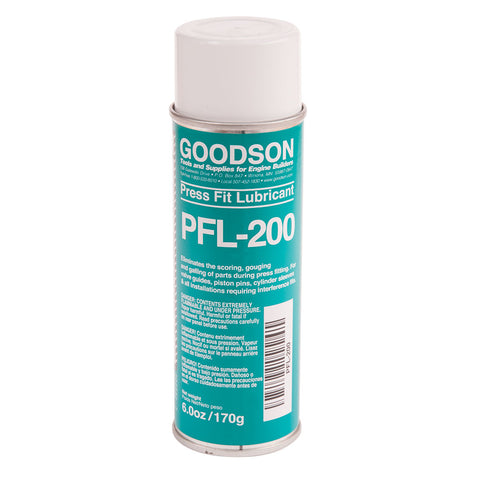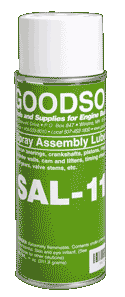By Chris Jensen, retired
When I was asked to write this piece on Assembly Lubes, my first question, “How much space do you have?”
I’ve been in this business for over 30 years and a lot has changed. How would I boil all of that down to fit into a brief piece? So I did some online research to add to what I already knew. Wouldn’t you know it; there’s tons of information out there. In fact, when I Googled “engine assembly lubes” I got 4.5 million (yes, million!) results.
Rather than rehash everything that’s already been said about assembly lubes, I’m going to give you a brief rundown of the products Goodson carries and where to use each one.
But before I do that, let’s talk about the purpose of assembly lubes.
When you start assembling an engine you’re going to be putting metal against metal. To protect that metal, you need some kind of lube. That’s where assembly lubes come in. Assembly lubes are intended to protect the metal from overheating and reduce friction on initial start-up. Sounds easy, right? Wrong. Different surfaces need different types of lubrication and that brings us back to the products that Goodson carries.

These assembly lubes are used for exactly what the name implies – pressing parts together. They’re ideal for valve guides, piston pins, cylinder sleeves, etc. This light weight lube is available as a spray or in a can with a brush applicator. It’s applied to the parts you’re pressing together to avoid scoring, gouging and galling.
Spray Assembly Lube
Like the name says, this lube is also a spray. It is ideal for lubricating areas that are hard to reach with a traditional lube. Goodson recommends using Spray Assembly Lube on valve train components to eliminate critical run-in of new and rebuilt high performance parts.
Extreme Pressure Lube
One of the biggest problems that needed to be overcome with assembly lubes was the high pressure exerted in some parts of the engine. This pressure can cause lubes to break down, making them ineffective. That led to a whole group of lubes for extreme pressure (EP) including Goodson’s Extreme Pressure Lube. This product is a highly refined petroleum product in a grease form that contains no lead, graphite or minerals. Being a grease based product, Extreme Pressure Lube goes on thick and as the engine heats and oil circulates, the grease base breaks down and mixes with the oil. This is what you want to happen. You don’t want a grease base that is not oil soluble as the substrate will break down under heat and pressure and wind up in your oil filter or worse, plugging up an oil feed hole. Not good, if you know what I mean.
We recommend Extreme Pressure Lube for pushrod tips, rocker arms, valve stem tips, distributor drive gears and blower drive gears and most engine fasteners.
 Cam-Shield® Camshaft Assembly Paste
Cam-Shield® Camshaft Assembly Paste
This is our newest addition to the Goodson Assembly Lube assortment. Again, as the name implies, this assembly paste is for use with camshafts (especially flat-tappet camshafts) and lifters. It provides anti-wear protection during break-in. The most important component of Cam-Shield is ZDDP, or Zinc Dialkyl Dithiophosphate. Now you know why they call it ZDDP.
ZDDP is another extreme pressure additive which is essential to make up for the lack of zinc in most commercial motor oils today. This zinc helps the lube cling to the part in question until break-in has occurred.
We recommend Cam-Shield for racing, street, classic, ag, diesel and marine camshafts including mechanical and hydraulic camshafts and lifters.
 Blood Friction Master® Engine Assembly Lube
Blood Friction Master® Engine Assembly Lube
First of all, this product has nothing to do with blood. It was created by the Alan C Blood Company, which is where the name originates.
Blood Friction Master contains a low friction additive (PTFE) for use in dry start-ups. The creamy formula forms a slick wall between moving parts to protect them during start-up pressure and will cling until it is dissolved by the circulating oil. If your assembled engine is going to sit for a while before start-up, this is the product to use as it has great long-term protection. Use Blood Friction Master on engine bearings.

Last, but certainly not least, is the popular First Lube, a semi-synthetic assembly lube containing Zinc and Moly as well as other high pressure additives for maximum break-in protection. First Lube is compatible with all oils.
Use First Lube to pre-lube bearings, cams, lifters and valve trains. The tacky formula makes it easy to apply and the green color makes it easy to see where you’ve applied it.
As you can see, there are many Assembly Lube options available, and I’ve barely scratched the surface. If you’re interested in reading more about Assembly Lubes and Break-In Oils, check out Engine Builder Magazine’s website and search for Assembly Lubes. And as always, if you have any questions about this piece or any other technical question, contact the Goodson Techxperts at 1-800-533-8010 or email us.


